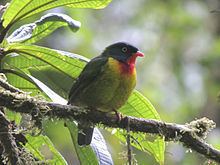Phylum Chordata Rank Species | Family Cotingidae Higher classification Pipreola Order Passerine | |
 | ||
Similar Pipreola, Masked fruiteater, Fiery‑throated fruiteater, Black‑chested fruiteater, Band‑tailed fruiteater | ||
The scarlet-breasted fruiteater (Pipreola frontalis) is a species of bird in the family Cotingidae. It is found in Bolivia, Ecuador, and Peru where its natural habitat is subtropical and tropical moist montane forests. Two subspecies are recognised though some researchers consider these should be regarded as distinct species. It is a plump green bird with a black head, the males having red throats and the females yellow. It is a relatively common species with a wide range, and the International Union for the Conservation of Nature has rated its conservation status as being "least concern".
Contents
Taxonomy and systematics
First described by British ornithologist Philip Sclater in 1858, the scarlet-breasted fruiteater is one of eleven species in the genus Pipreola. Its type specimen is held at the Academy of Natural Sciences of Drexel University, in Philadelphia. The species is closely related to the fiery-throated fruiteater, but is found at higher elevations. There are two subspecies, which some taxonomists think represent two distinct species.
The genus name given to the fruiteaters, Pipreola, is a diminutive of Pipra, which is the genus name Carl Linnaeus gave to the similarly shaped manakins. The specific name frontalis is a Modern Latin word meaning "fronted" or "browed".
Description
Like all Pipreola fruiteaters, the scarlet-breasted fruiteater is a plump, short-tailed cotinga. It is relatively small for a fruiteater, measuring 15.5–16.5 cm (6.1–6.5 in) in length; its mass ranges from 39.5 to 45.3 g (1.39 to 1.60 oz), with an average of 42.4 g (1.50 oz). The species is sexually dimorphic; the male is considerably more colorful than the female. Both sexes have bright green upperparts, with narrow yellow tips to the tertial feathers. The male's throat and upper breast are bright red (less extensively colored in P. f. squamipectus than in P. f. frontalis), while the female's underparts are yellow with green scaling or spots. Its legs and feet are pink or orange.
Distribution and habitat
The scarlet-breasted fruiteater is restricted to the eastern slope of the Andes from northeastern Ecuador through eastern Peru to central Bolivia. It is found in montane forests at elevations ranging from 900–2,000 m (3,000–6,600 ft) above sea level.
Behavior
The scarlet-breasted fruiteater is arboreal and often occurs higher up, from mid-levels to sub-canopy, than many other members of its genus. Like other fruiteaters, it tends to be rather lethargic.
Feeding
As its name suggests, the scarlet-breasted fruiteater eats primarily fruit, which it picks while hover-gleaning or, less frequently, while perched.
Voice
The scarlet-breasted fruiteater's vocalizations are generally short, high-pitched and infrequent. The song of the P. f. squamipectus male is sharp and ascending, variously transcribed as "psii" or "tsweeet", while the song of the P. f. frontalis male is longer and more complex—a thin, rising trill that becomes a descending whistle, transcribed as "ti'ti'ti'ti'ti'ti'tseeeeeeeeer". Its call is a very high-pitched pseet.
Conservation and threats
The International Union for Conservation of Nature (IUCN) categorizes the Scarlet-breasted Fruiteater as a species of "least concern", based on its very large range and its status as a fairly common species within its range. However, its population size has never been quantified, and is thought to be decreasing.
